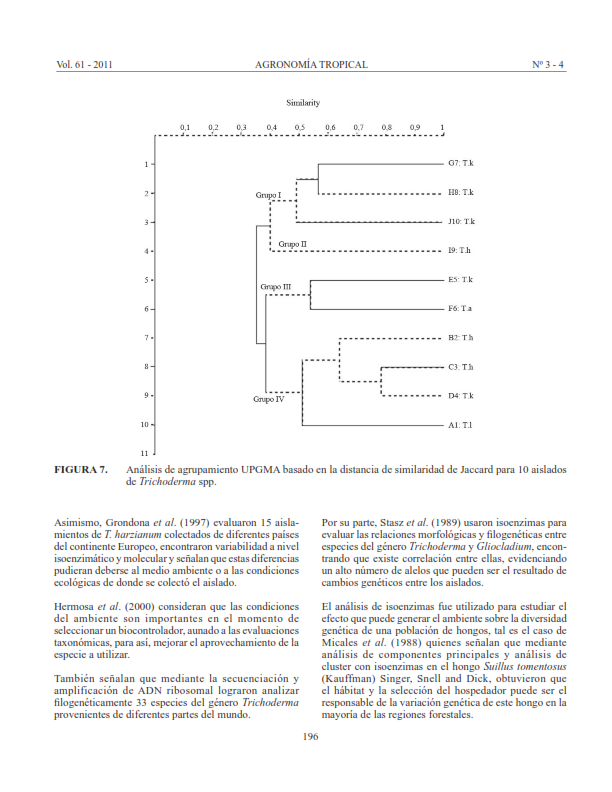Isoenzymatic characterization of isolated from Trichoderma spp
Abstract
Recently it has been shown that the techniques are highly isozyme support traditional morphological criteria clearly delineated within and between species, as well as the relationship between pathogenic and electrophoretic tests among these microorganisms. The research aimed to implement the use of isozyme technique to characterize the genetic variability of isolates of Trichoderma spp. Were used Trichoderma isolates including T. harzianum, T. koningiopsi, T. longibrachiatum and T. atroviride from southern Aragua State and northern Guárico State. Isozyme twelve systems were evaluated: alpha and beta esterase, alcohol dehydrogenase, malate dehydrogenase, alkaline phosphatase, acid phosphatase, peroxidase, glutamate oxaloacetate transaminase, isocitrate dehydrogenase, malic enzyme, glucofosfo isomerase, glutamate dehydrogenase. A cluster was performed using as a metric distance (the distance of Jaccard similarity), the data is analyzed using Past® Version 1.55. According to the isoenzyme electrophoretic patterns, there is variability in the isolates, this due to the formation of four groups corresponding to the locations of collections and not evaluated Trichoderma species. Cluster analysis (cluster) revealed the formation of 4 groups. I and II, formed by isolates from Aragua State. The III, composed of the isolated from production areas Guárico and Aragua States, consisting of Group IV isolates from Guárico State.
Downloads
References
• Bissett, J. 1991b. A revision of the genus Trichoderma III. Section Pachybasium. Canadian Journal of Botany 69:2.373-2.414.
• Bissett, J. 1991c. A revision of the genus Trichoderma IV. Aditional notes on section Longibrachiatum. Canadian Journal of Botany 69:2.418-2.420.
• Bonde, M., G. L. Peterson and J. L. Y. Maas. 1991. Isozyme comparisons for identification of Colletotrichum species pathogenic to strawberry. Phytopathology 81:1.523-1.528.
• Gantoti, B. and M. Davis. 1993. Pectic zymogram analysis for characterizing genetic diversity of the mango anthracnose pathogen. Acta Horticulturae 341:353-359.
• García, J., A. Trigos, L. Andreu, N. Estevez y M. Luna. 2011. Variaciones Isoenzimática y Patogénica de Fusarium spp., asociadas con la pudrición de tallo y raíz de vainilla. Tropical and SubtropicalAgroecosystems 13:299-306.
• González, I., D. Infante, B. Martínez, Y. Arias, N. González, Ll. Miranda y B. Peteira. 2012. Inducción de quitinasas y glucanasas en cepas de Trichoderma spp., promisorias como agentes para el control biológico. Biotecnología Aplicada 29:7-11.
• Grondona, I., M. R. Hermosa, M. Tejada, M. D. Gomis, P. F. Mateos, P. D. Bridge, E. Monte and I. Garcia-Acha.1997. Physilogical and biochemical characterization of Trichoderma harzianum, a biological control agent against soilborne fungal plant pathogens. Applied and Environmental Microbiology 63:3.189-3.198.
• Hermosa, M. R., I. Grondona, I. A. Iturriaga, J. M. Díaz- Minguez, C. Castro, E. Monte and I. Garcia-Acha. 2000. Molecular characterization and identification of biocontrol isolates of Trichoderma spp. Applied and Enviromental Microbiology. American Society for Microbiology 66(5):1 890-1 898.
• Lugo F., Zunilde C. 1998. Identificación de razas deFusarium oxysporum f. sp. lycopersici (Sacc) Snyder& Hansen procedentes de algunas zonas productoras del estado Aragua y norte de Guárico. Tesis de Maestría. Universidad Central de Venezuela. Facultad de Agronomía. Maracay 101 p.
• Magnano, G., F. Scala and Q. Michelli. 1995. Moderne tecnichnique diagnostiche in mycologie phytopathology. Petria 5:53-90.
• Marlatt, M., J. Correll and P. Kaufman. 1996. Two genetically distinct populations of Fusarium oxysporum f. sp. lycopersici race 3 in the united Stated. Plant Disease 80:1 336-1 342.
• Micales. J. A, R. M. Bonde and G. L. Peterson. 1986. The use of isoenzymes analisis in fungal taxonomy and genetics. Mycotaxon 27:405-449.
• Micales, J. A., R. M. Bonde and G. L. Peterson. 1988. Izoenzyme analysis and aminopeptidase activities within the genus Peronosclerospora. Phytopathology 78:1 396-1 402.
• Nealson, K. and E. Garber. 1967. A electrophoreses survey of esterases, phosphatases and lemineaminopectidasas in micelial extracts of species of Aspergillus. Mycología 59:330-336.
• Rifai, M. A. 1969. A revision of the genus Trichoderma. Mycological paper N° 116.
• Sanabria de, A. N. 1998. Serología y electroforesis para identificación de tres especies de Fusarium. Tesis de doctorado. Maracay, Ven. Universidad Central de Venezuela 102 p.
• Sasz, Nixon, G. Harman and F. Weeden. 1989. Evaluation of phonetic species and phylogenetic relationships in the genus Trichoderma by cladist analysis of isoenzyme polymorphism. Mycologia 81:391-403.





